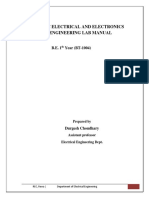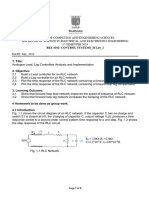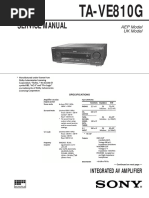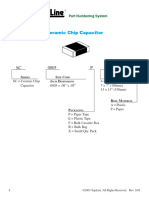Lab 5 Parallel Circuit
Uploaded by
abdullLab 5 Parallel Circuit
Uploaded by
abdullPARALLEL CIRCUITS, CURRENT DIVIDER
OBJECTIVE:
Correctly measure the currents and voltage of a Parallel DC circuit
To examine basic parallel DC circuits with resistors
To investigate current divider rule (CDR)
To verify KCL
THEORY:
Kirchhoff’s current law
In a parallel circuit as per above figure, the voltage across parallel elements is the same. Therefore,
V1 = V2 = V3 = E
For the network of Figure above, the currents are related by Kirchhoff’s current law
Is = I1+I2+I3
and the current through each resistor is simply determined by Ohm’s law:
I1= E/R1, I2 = E/R2, I3 = E/R3
The current divider rule
Current Divider Rule (CDR) states that the current through one of two parallel branches is equal
to the resistance of the oilier branch divided by the sum of the resistances of the two parallel branches and
multiplied by the total current entering the two parallel branches. That is, for the networks of Fig. below.
EQUIPMENT:
Department of Electrical Engineering Technology, PTUT, Lahore
DC power supply
Resistors
DMM
PROCEDURE– CURRENT DIVIDERS
1. Check out a DMM
2. Construct the circuit shown in Figure 5-1
3. Make the Measurements and Calculations needed to complete Table and Table 5.2
Calculate the currents and resistances using the ACTUAL measured values for V, I, and
R.
Calculate the Δ% for the measured value as compared to the calculated from theory for
an arbitrary quantity, Q, as
Qcalc −Qmeas
∆ %Q=
Qmeas
NOTE
The Ammeter MUST be connected in series with NO potential across it; i.e., do NOT
connect the ammeter ACROSS Vs or any R.
Figure 5-1
Current Divider. Vs = 9.00 Vdc. R1 = 1.4-2.5 kΩ. R2 = 3.0-4.8 kΩ.
RAW DATA AND CALCULATIONS:
Department of Electrical Engineering Technology, PTUT, Lahore
Actual Values
Vs =
R1 =
R2 =
I meas−I calc
∆ %= × 100
I calc
Value Determination IT I1 I2
Calculated
Measured
%
Table 5.1 – Current Divider V/I Measurements and Calculations
Rmeas −Rcalc
∆ %= ×100
R calc
Value Determination RT R1 R2
Calc by V/Imeas
DMM Measured
%
Table 5.2 – Current Divider Resistance Calculations
LEARNING OUTCOMES:
At the end of this lab students will be able to
Identify a resistive current divider and apply the current division formula to analyze
DC circuits
apply Kirchhoff's current laws to parallel resistive circuit
QUESTIONS
1. How to find the Equivalent resistance in parallel circuit?
2. What is CDR?
3. Why CDR gives current only up to two branches?
4. Is KCL satisfied in Table 5.1 and Table 5.3?
5. If a fourth resistor of 10 kΩ was added next to R3 in Figure 5-2, how would this alter the currents
in each branch? Show work.
Department of Electrical Engineering Technology, PTUT, Lahore
You might also like
- Electricalcircuitsanalysis Digital NotesNo ratings yetElectricalcircuitsanalysis Digital Notes111 pages
- ELECTRICAL CIRCUIT ANALYSIS-DIGITAL NOTES (1) - CompressedNo ratings yetELECTRICAL CIRCUIT ANALYSIS-DIGITAL NOTES (1) - Compressed7 pages
- UNIT-1: Lecture Notes Unit 1: Transient AnalysisNo ratings yetUNIT-1: Lecture Notes Unit 1: Transient Analysis36 pages
- Phy 108: Electricity & Magnetism E 1: O ' L 1. ObjectivesNo ratings yetPhy 108: Electricity & Magnetism E 1: O ' L 1. Objectives4 pages
- Capacitance Meter: Department of Engineering The Australian National UniversityNo ratings yetCapacitance Meter: Department of Engineering The Australian National University24 pages
- Advanced Controlling of Transformer ParallelingNo ratings yetAdvanced Controlling of Transformer Paralleling6 pages
- Electrical Circuit Analysis-Digital Notes (1) - CompressedNo ratings yetElectrical Circuit Analysis-Digital Notes (1) - Compressed111 pages
- Circuit Analysis and Design Manual FinalNo ratings yetCircuit Analysis and Design Manual Final65 pages
- Addis Ababa Science and Technology University Collage of Electrical and Mechanical Engineering Department of Electromechanical EngineeringNo ratings yetAddis Ababa Science and Technology University Collage of Electrical and Mechanical Engineering Department of Electromechanical Engineering6 pages
- Experiment 2 Circuit Simplification A. Series and Parallel Circuit. B. Star and Delta TransformationNo ratings yetExperiment 2 Circuit Simplification A. Series and Parallel Circuit. B. Star and Delta Transformation12 pages
- DC Lab Exp 2 Student Manual (Fall 22-23)No ratings yetDC Lab Exp 2 Student Manual (Fall 22-23)6 pages
- Mohosin Ahmed Shisir - 233016010 - LR2 - EEE 1204 - Electric Circuit II LabNo ratings yetMohosin Ahmed Shisir - 233016010 - LR2 - EEE 1204 - Electric Circuit II Lab9 pages
- Design of Electrical Circuits using Engineering Software ToolsFrom EverandDesign of Electrical Circuits using Engineering Software ToolsNo ratings yet
- A Multi-Agent Reinforcement Learning Based Data-Driven Method For Home Energy ManagementNo ratings yetA Multi-Agent Reinforcement Learning Based Data-Driven Method For Home Energy Management10 pages
- Article: Multi-Objective Energy Management in Microgrids With Hybrid Energy Sources and Battery Energy Storage SystemsNo ratings yetArticle: Multi-Objective Energy Management in Microgrids With Hybrid Energy Sources and Battery Energy Storage Systems20 pages
- Journal of Energy Storage: SciencedirectNo ratings yetJournal of Energy Storage: Sciencedirect16 pages
- Renewable and Sustainable Energy Reviews: Eneko Unamuno, Jon Andoni BarrenaNo ratings yetRenewable and Sustainable Energy Reviews: Eneko Unamuno, Jon Andoni Barrena9 pages
- Field Control of DC Shunt Machine IN MATLABNo ratings yetField Control of DC Shunt Machine IN MATLAB7 pages
- Module 4: Electrical Theory: On Completion of This Module, You Will Be Able To100% (1)Module 4: Electrical Theory: On Completion of This Module, You Will Be Able To5 pages
- Experiment No. 1 Analysis of Resistive Networks ObjectivesNo ratings yetExperiment No. 1 Analysis of Resistive Networks Objectives12 pages
- JFET Circuits II: University of California at Berkeley Physics 111 Laboratory Basic Semiconductor Circuits (BSC) Lab 5No ratings yetJFET Circuits II: University of California at Berkeley Physics 111 Laboratory Basic Semiconductor Circuits (BSC) Lab 511 pages
- Elk Device Building Docs 15th February 2023No ratings yetElk Device Building Docs 15th February 20239 pages
- Intro To Arduino Tutorial No Hardware or Experience Required 1No ratings yetIntro To Arduino Tutorial No Hardware or Experience Required 137 pages
- Ba6956an, Ba6287f, Ba6285fs, Ba6285afp Y, Ba6920fp yNo ratings yetBa6956an, Ba6287f, Ba6285fs, Ba6285afp Y, Ba6920fp y18 pages
- LG 22lg3000 22lg3010 Chassis Ld84a SM (ET)No ratings yetLG 22lg3000 22lg3010 Chassis Ld84a SM (ET)88 pages
- ET304A Electric Circuits Laboratory Lab 1 Kirchhoff's Voltage and Current LawsNo ratings yetET304A Electric Circuits Laboratory Lab 1 Kirchhoff's Voltage and Current Laws4 pages










































































































